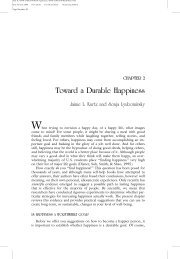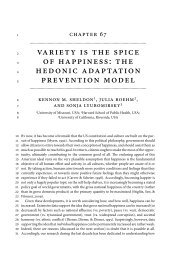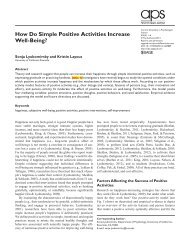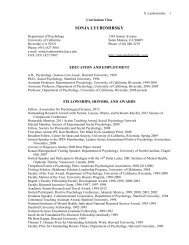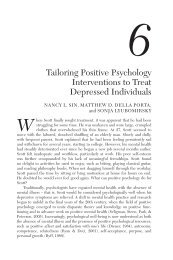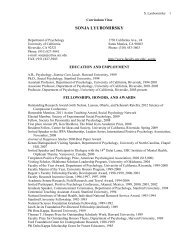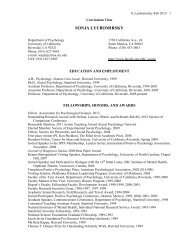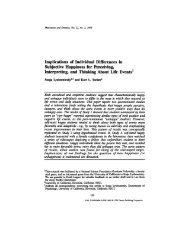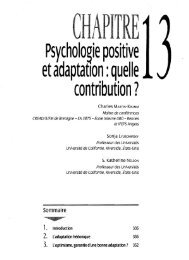Maximizing Versus Satisficing: Happiness Is a Matter of Choice
Maximizing Versus Satisficing: Happiness Is a Matter of Choice
Maximizing Versus Satisficing: Happiness Is a Matter of Choice
Create successful ePaper yourself
Turn your PDF publications into a flip-book with our unique Google optimized e-Paper software.
MAXIMIZING VS. SATISFICING AND WELL-BEING<br />
1181<br />
zation/regret survey and the same 10-item measure <strong>of</strong> self-esteem (Rosenberg,<br />
1965).<br />
Factor Analysis<br />
Results<br />
We conducted a PCA on the combined samples (n 1,747) to<br />
determine the factor structure <strong>of</strong> the regret and maximizing items.<br />
We sought the solution that best approximated a simple structure—that<br />
is, the one in which most <strong>of</strong> the items loaded on at least<br />
one factor, and each item loaded on only one factor. What<br />
emerged, on the basis <strong>of</strong> a varimax rotation, was a six-factor<br />
solution. However, two <strong>of</strong> the factors contained only two items<br />
each, and one item failed to load on any <strong>of</strong> the factors. In addition,<br />
the item-total correlations for all but one <strong>of</strong> these five items were<br />
quite low. We thus eliminated the four items with low item-total<br />
correlations, resulting in a 13-item Maximization Scale and a<br />
five-item Regret Scale. We conducted another PCA on these 18<br />
items. The resulting four-factor solution is presented in Table 1.<br />
The first factor, on which all five regret items loaded, references<br />
“regret,” and makes up the Regret Scale. The other factors are<br />
subcategories <strong>of</strong> maximizing/satisficing and make up the Maximization<br />
Scale. The second and third factors are largely behavioral<br />
examples <strong>of</strong> maximizing. The second factor includes being open to<br />
better jobs, songs on the radio, television shows, and relationships,<br />
liking lists that rank things, and fantasizing about alternatives to<br />
reality (which also loaded on the “regret” factor, though its loading<br />
was lower than that <strong>of</strong> the other “regret” items; in addition, this<br />
item was judged by 9 <strong>of</strong> our 11 informants to be more about<br />
maximizing and satisficing than about regret). The third factor,<br />
which concerns primarily shopping behaviors, includes shopping<br />
for a friend, renting videos, and shopping for clothing. Writing<br />
several drafts <strong>of</strong> letters so as to word things just right also loads on<br />
this factor. The fourth factor represents having high standards,<br />
both for oneself and for things in general. One <strong>of</strong> the items that<br />
loaded on this factor also loaded on the “regret” factor. Its loading<br />
on the “regret” factor was substantially lower than all the other<br />
regret items, and also lower than its loading on this “maximizing”<br />
factor. Moreover, this item was judged by 10 <strong>of</strong> our 11 informants<br />
to be about maximizing. All further analyses, in this and subsequent<br />
studies, used responses to the modified, 13-item Maximization<br />
Scale rather than the 17-item scale participants actually saw.<br />
The correlation (across all participants) between scores on the 13-<br />
and the 17-item scales was .99 ( p .001). Cronbach’s alpha was<br />
.71 for the Maximization Scale and .67 for the Regret Scale.<br />
Correlations With Standard Personality Measures<br />
Sample 1. Table 2 presents the Pearson’s zero-order correlations<br />
between the variables investigated in Study 1. As can be seen<br />
in the table, a tendency for participants to be maximizers rather<br />
than satisficers ( .70) was significantly correlated with a<br />
tendency to experience more regret and depression, as well as to be<br />
less optimistic, and less happy ( p .06). By way <strong>of</strong> further<br />
illustration, <strong>of</strong> the 18 people who scored 8 or above on the BDI-SF,<br />
qualifying for a diagnosis <strong>of</strong> at least mild depressive symptoms<br />
(Beck & Beck, 1972), 8 (44%; Mean BDI score 13.25) also<br />
scored in the top quartile for maximization, whereas only 1 (6%;<br />
BDI score 8) scored in the bottom quartile. By contrast, <strong>of</strong><br />
the 19 people scoring in the top quartile for happiness, 8 (42%;<br />
Mean SHS score 16.88) were in the bottom quartile for maximization,<br />
whereas only 3 (16%; Mean SHS score 16.33) were in<br />
the top quartile.<br />
Sample 2. Table 2 also presents the correlations between the<br />
13-item maximization composite ( .60) and the five-item<br />
regret composite ( .78) for Sample 2, along with the BDI-SF<br />
and the SHS—the only other measures administered to this sample.<br />
Once again, we observed strong associations between maximization<br />
and a tendency to experience regret and depression, and<br />
lower levels <strong>of</strong> happiness.<br />
Sample 3. Our third sample provided a further opportunity to<br />
investigate relations between maximization and various personality<br />
constructs. Table 2 presents the intercorrelations between the<br />
maximization composite ( .70), the regret composite ( <br />
.70), and measures <strong>of</strong> optimism, happiness, depression, neuroticism,<br />
and satisfaction with life. Correlations between maximizing<br />
and the constructs <strong>of</strong> regret, depression, and satisfaction with life<br />
were significant beyond the p .01 range. In addition, maximizing<br />
was negatively correlated with optimism ( p .05) and happiness<br />
( p .10). However, the relation between maximizing and<br />
neuroticism was not significant ( p .10). In sum, in addition to<br />
replicating the results found with Sample 1, this sample provided<br />
evidence for a strong relation between maximization and diminished<br />
life satisfaction, as well as a nonsignificant relation with<br />
neuroticism.<br />
Sample 4. Table 2 presents data from our fourth sample on the<br />
relations between the maximization composite ( .63), the<br />
regret composite ( .73), and the SHS. Once again, the correlation<br />
between maximizing and regret was significant, although the<br />
relation between maximizing and happiness was modest (r .10,<br />
p .05).<br />
Sample 5. The fifth section <strong>of</strong> Table 2 displays the correlations<br />
between maximizing ( .70), regret ( .74), happiness, and<br />
depression for the sample <strong>of</strong> health care providers who completed<br />
the relevant measures. As seen with the previous samples, a<br />
tendency to score highly on the Maximization Scale was predictive<br />
<strong>of</strong> greater regret and depression, as well as lower levels <strong>of</strong> selfreported<br />
happiness.<br />
Sample 6. The sixth section <strong>of</strong> Table 2 presents correlations<br />
for participants approached at the urban train station. Once again,<br />
maximizing ( .72) was positively correlated with regret ( <br />
.67), and negatively correlated with happiness. In addition, maximizing<br />
was significantly correlated with perfectionism (r .25,<br />
p .001). And for the subsample who completed the relevant<br />
measure, maximizing and self-esteem were negatively correlated<br />
(r .30, p .001). Interestingly, however, whereas maximizing<br />
and perfectionism were significantly correlated, neither happiness<br />
(r .12, p .08) nor self-esteem (r .02, ns) correlated<br />
significantly with perfectionism. Indeed, if anything, the relation<br />
between perfectionism and happiness was positive rather than<br />
negative.<br />
Sample 7. The final sample, taken from prospective jury members,<br />
replicated the significant association between maximizing<br />
( .73) and self-esteem exhibited by the subsample in Sample 6,<br />
(r .26, p .01).<br />
Across the seven samples, maximization scores ranged<br />
from 1.15 to 6.62, with a mean <strong>of</strong> 3.88 and a median <strong>of</strong> 3.85. Also,<br />
across all samples, the correlation between maximizing and regret



